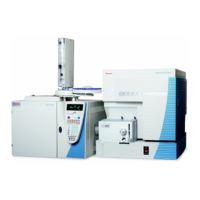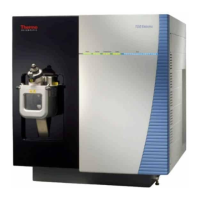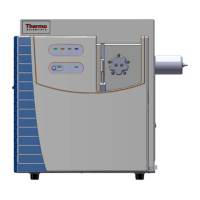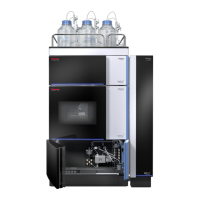1
Introduction
Ion Polarity Modes
Thermo Scientific TSQ Quantum XLS Series User Guide 5
In isobutane positive ion mode CI, the main peak observed is MH
+
.
In ammonia positive ion mode CI, the main peaks observed are MH
+
and [M+NH
4
]
+
.
Negative sample ions are most commonly formed by one of the following:
• Sample molecules that capture the secondary thermal electrons present in the ion source
• Electron transfer from ionized reagent gas (for example, NH
2
-
)
• Proton abstraction
Molecular ions observed in negative ion chemical ionization mass spectra are usually M
-
or
[M-H]
-
.
Ion Polarity Modes
You can operate the TSQ Quantum XLS Series mass spectrometers in either of two ion
polarity modes: positive or negative. Both positively charged and negatively charged ions form
in the ion source of the mass spectrometer. The mass spectrometer controls whether positive
ions or negative ions are transmitted to the mass analyzer for mass analysis by changing the
polarity of the potentials applied to the ion source and ion optics. The ion optics deliver the
ions produced in the ion source, in a collimated beam, to the mass analyzer. The mass
spectrometer can switch between positive and negative polarity modes in under 95 ms.
Because the information obtained from a positive-ion mass spectrum is different from and
complementary to the information from a negative-ion spectrum, the ability to obtain both
positive-ion and negative-ion mass spectra aids you in the qualitative analysis of your sample.
You can choose the ion polarity mode and ionization mode to obtain maximum sensitivity for
the particular analyte of interest.
Scan Modes
You can operate the TSQ Quantum XLS Series mass spectrometers in a variety of scan modes.
The most commonly used scan modes can be divided into two categories: single mass
spectrometry (MS) scan modes and tandem mass spectrometry (MS/MS) scan modes. The
scan modes in each category are as follows:
• MS scan modes: Q1MS and Q3MS scan modes
• MS/MS scan modes: Product scan mode, Parent scan mode, Neutral Loss scan mode
• Data-dependent scan mode
The scan modes that you can employ depend on the number and type of rod assemblies and
the voltages applied to the rod assemblies.

